Read Reviews
The Best Cat Repellents
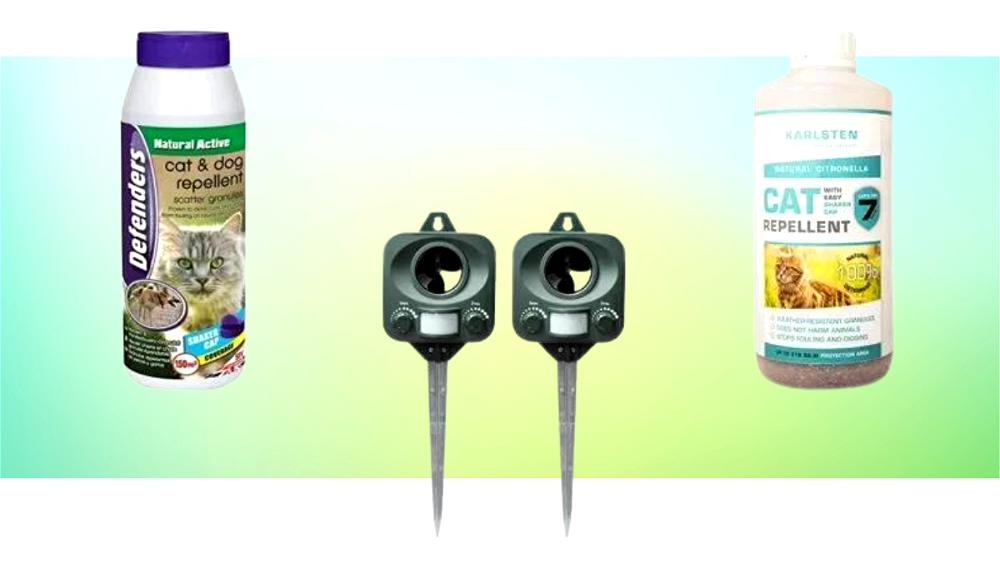
-
Pestbye® Battery Operated Cat Repellent
-
Defenders Cat and Dog Scatter Granules
-
Karlsten Cat Repellent Anti Fouling Granules
-
Defenders Pepper Dust
-
Princessk Ultrasonic Cat Repellent
-
PestShield Move It Cat & Dog Garden Repellent
-
Black Cat Silhouette for Garden
Cat Repellent Reviews
- Jumps between frequency levels which provides a short and sharp shock - more effective than some other ultrasonic frequencies
- Won’t affect birds but does work for dogs, cats and foxes
- Easy to set up - simply push into the ground or wall mount
- Long battery life of around 4 months
- Two units included so large coverage area overall
- Battery compartment uses four Phillips screws so can be awkward to undo
- Ultrasonic sound can still be heard by some people, particularly on low frequencies
- Performance
- 4.5
- Ease of Use
- 5
- Features
- 4.5
- Value for Money
- 4.5
The Pestbye® Battery Operated Cat Repellent are a set of ultrasonic cat deterrents with a slightly different design compared to many others on the market.
While some ultrasonic repellers use a gradually increasing frequency, or a rhythmically fluctuating frequency, this cat repellent uses a HRF (HyperResonance) frequency. This jumps between frequency levels, providing a short, sharp burst of surprising sound to the visiting animal. This means that cats and other unwanted visitors are less likely to get used to the sound of this cat repellent. It’s also, therefore, reasonably effective at scaring them away.
These cat repellents come in a set of two meaning they can be placed at opposite ends of the garden to scare away intruders. Each one has a large coverage area, up to 10 m away from the unit. The motion sensor detects animals and activates the frequency.
These repellers are very easy to use. They run off 3 x AA batteries and come with a stake so can be easily pushed into the ground. Alternatively, it’s possible to wall mount the units as they come with a hanging hook.
Designed to be left out in the UK weather, these cat repellents are both waterproof and dustproof; they have an IP44 rating. The only thing required in terms of maintenance is changing the batteries when they run out; however, the battery life is a reasonable four months (if the unit is activated an average of 10 times per day).
The only thing these cat repellents are missing is a solar charging capability. Changing the batteries is a little fiddly as there are four small Phillips screws protecting the compartment. It’s easy enough to do, but the cat repellents with solar charging add another level of simplicity.
It’s also possible that some humans may occasionally be able to hear these frequencies. If you have particularly sensitive hearing, you may wish to place these further away from your home.
Overall, these are some of the best cat repellents if you want a unit that uses this specifically-designed ‘HyperResonance Frequency’. It may help stop some cats from getting too accustomed to the use of ultrasonic sound.
Did you find this review helpful?
- Easy to sprinkle in areas of the garden thanks to the shaker cap
- Contains garlic which will help repel cats without harming them
- Won’t cause damage to plants or borders
- Good value for money with one tub covering 150 m²
- Biodegradable so won’t sit on the lawn forever
- All areas that cats have visited should be cleaned and washed down otherwise scent won’t be strong enough to deter cats
- May not prevent cats from totally visiting your garden but does seem to prevent them using it as a litter box
- May deter other animals or bugs, including bees
- Needs regular application - especially if there's been heavy rainfall
- Performance
- 4.5
- Ease of Use
- 5
- Features
- 4.5
- Value for Money
- 5
The Defenders Cat and Dog Scatter Granules offer a simple method that works well to deter both cats and dogs. These granules are biodegradable, coated with garlic to produce a strong smell that cats dislike. They’re one of the best cat repellents if you’re after a simple, spreadable option (this one specifically is garlic-based).
To use these granules, simply sprinkle them in the areas of your lawn that cats tend to visit the most. This 450 g carton will cover 150 m², so you should have enough for a medium size garden. As these granules are biodegradable and only contain natural ingredients, they can be sprinkled on borders, plants and pathways without causing damage.
For easy distribution, this repellent also comes with a shaker cap. This means it can simply be sprinkled on the areas that cats, dogs and foxes visit. You don’t need to weigh it out or use a separate spreader. Before application, you should ensure that the garden areas are clean – any remnants of faeces may encourage the cat back again.
One of the best things about this cat repellent is that it doesn’t use any jump-scare tactics. Although Some users have found that cats still visit their garden after using this product, they are less likely to defecate on the lawn or flowerbeds.
Overall, this cat repellent is very good value for money. While not perfect, it does a good job and is a low cost option. One thing to note is that regular application is needed, especially if it rains. You may also find that insects (such as bees) are deterred from your garden too.
If you’re looking for an easy to use and good value cat repellent, the Defenders Cat and Dog Scatter Granules are well worth considering.
Did you find this review helpful?
- The citrus scent, even though not strong smelling, is fairly pleasant
- Good coverage area of 218 sqm
- Works very well to deter cats from using your garden as a toilet
- Contains natural ingredients and won’t harm cats
- Won’t deter cats from visiting your garden, simply stops them from visiting specific areas
- Reapplication is required for the first couple of weeks
- Performance
- 4
- Ease of Use
- 4.5
- Features
- 4
- Value for Money
- 4
Designed to prevent unwelcome felines from defecating in your garden, these Karlsten Cat Repellent Anti Fouling Granules use a natural formula that won’t harm plants or wildlife. They contain Citronella to deter cats, making them one of the best cat repellents if you want a natural, citronella-based formula.
The granules are easy to apply and can be easily sprinkled onto the lawn. The scent of these granules mask territorial markings, stopping cats from marking your garden as part of their territory. This is good news for preventing cats from leaving mess behind as well as deterring them from digging up flower beds.
One of the best things about these granules is that they are weather resistant and remain effective for seven days after application – even if it rains. For best results, the manufacturer recommends reapplying over a period of two weeks.
One tub of this cat repellent offers coverage of 218 m² and there is a shaker cap that makes application relatively easy. It’s quite easy to use these granules quickly, so be aware of this when applying them.
There are a lot of natural cat repellents on the market that use garlic, which some people dislike the smell of. If you’re happier with the smell of citronella, these granules can add a refreshing scent to your garden!
Overall, this repellent offers a natural solution which helps prevent neighbourhood cats from digging and fouling in your garden.
Did you find this review helpful?
- Biodegradable so won’t harm any plants or wildlife
- Works fairly well in dry weather
- Easy to use and apply to different patches of lawn
- Pepper-based product gives an alternative to citronella and garlic
- Only enough product to cover 10 m² - best for patches/small gardens
- Needs to be reapplied if it rains
- Shaker applicator isn’t the best quality and may not last very long
- Performance
- 4.5
- Ease of Use
- 5
- Features
- 4.5
- Value for Money
- 5
For treating small areas in the garden, consider this Defenders Pepper Dust. It prevents digging and fouling and can be used in front gardens, on lawns or on flower beds.
It comes in a 300 g bottle that covers 10 m²; therefore, it’s a good option if you’re worried about buying and wasting larger amounts of product. It comes in a ‘dust’ form, which will spread well over the desired area.
Like the other repellents I’ve mentioned, this pepper-based deterrent is welfare-friendly. It won’t harm animals and simply deters them. The bottle is fitted with a shaker cap which makes it easy to distribute the dust in the garden.
Given that the base ingredient is pepper, this product gives an alternative option to citronella or garlic products. If you find that you don’t like the smell of garlic or citronella, or haven’t found those products to be effective, this gives an alternative option to try.
The pepper dust degrades naturally without trace. It can be applied year-round; however, it’s best used in still, dry weather. For best results, it should be reapplied regularly, particularly after a rainy or very windy day.
Another thing to note is that you’ll need to remove all evidence of previous fouling or damage. Cats tend to foul in the same place each time. Cleaning these areas before applying the product will give you the best results.
Did you find this review helpful?
- 5 sensitivity modes to choose from depending on what animal you are trying to dete
- Small unit can be placed in a flowerpot to make it easy to move
- Two charging options - a solar panel and USB charging cable
- Fully waterproof and low maintenance so can simply be left outside
- Needs to be installed in a sunny area for the solar charging to work in the winter
- Cats may get used to the noise over time
- Some humans are able to hear the ultrasonic sounds
- Performance
- 4.5
- Ease of Use
- 5
- Features
- 5
- Value for Money
- 5
The Princessk Ultrasonic Cat Repellent has been designed to deter a range of unwelcome intruders, including cats. There are five sensitivity modes to choose from, depending on the size of the animal you are looking to deter. It can also be charged either by solar panels or via USB, making it one of the best cat repellents in terms of versatility.
This repellent is safe for both humans and animals. It has a PIR motion sensor that detects movement and triggers the ultrasonic sound. The sensor range is between 6 and 8 m, covering a 110° arc in front of the unit.
Its two charging options are useful for keeping it running. Most of the time, the solar panels will make this cat repellent free to charge. However, if there has been a spout of cloudy weather, it can be charged via USB as a backup.
Perfect for outdoor use, this cat repellent has a waterproof IPX4 rating. The hard plastic shell is very durable, so it can be used in winter as well as summer. It doesn’t need to be installed in a sheltered area, and it can be either hung on an object or mounted into the ground.
As with all ultrasonic deterrents, you may find that it’s more effective against some cats than others. There’s also a chance that some humans may be able to hear this, so if you have particularly sensitive hearing you should place it at the far end of your garden.
Overall, this is one of the best cat repellents if you’re after a versatile, low-maintenance option. One of the most useful things about it is that the batteries can be charged externally if necessary, but most of the time it can be left to do its thing and charge in the sun.
Did you find this review helpful?
- Non toxic so can be used on plants and won’t harm wildlife
- Ready to use formula that can simply be applied to areas of your lawn
- Smell isn’t too overpowering, which some people may prefer
- Needs to be reapplied when it rains
- Won’t deter cats from visiting your garden, but should stop them from defecating
- Performance
- 4.5
- Ease of Use
- 4.5
- Features
- 5
- Value for Money
- 4.5
The PestShield Move It Cat & Dog Garden Repellent comes with two bottles included, each containing 240g of powder. Therefore, it offers good value for money if you’re after a spreadable, powder product.
This repellent is organic and non-toxic, so it won’t harm the animals it deters. It can be used on borders, beds, pathways and driveways. Simply apply it to the areas of your lawn that are most frequently visited by cats. This is best done in dry weather, and you will need to reapply when it rains,
The scent isn’t as strong as some other repellents so it will need quite regular reapplication. It’s also quite lightweight so can scatter more than intended in windy weather.
It’s worth noting that whilst this repellent can be effective, it won’t prevent animals from entering your garden. Instead, it’s intended to deter them from fouling in the same areas. As with many of these repellent products, some cats will be deterred more than others.
This formula is ready to use and can be applied to your lawn and garden straight away.
Did you find this review helpful?
- Very low maintenance - simply place in the garden and leave to do their job
- Humane form of pest control
- Well made and can be left outside in all weathers thanks to powder coating
- Are a decorative addition to your garden unlike other repellents
- May also scare rodents, birds, rabbits and squirrels
- May only work to deter some cats - not the very brave ones!
- The marble eyes are possible to remove and may be a choking hazard for children
- Performance
- 5
- Ease of Use
- 4.5
- Features
- 5
- Value for Money
- 5
A fairly ‘classic’ cat repellent, the Black Cat Silhouette for Garden comes with three black cat silhouettes. They have reflective eyes intended to spook visiting cats into thinking they’re invading another cat’s territory. The three silhouettes are: a “scared cat”, a “sitting cat” and a “stalking cat”. Surely enough to send any unwanted feline running!
They’re the best cat repellents if you want a low maintenance option. There are no batteries to charge and no product to reapply.
These cat scarers have bright marble eyes that’ll scare off cats, rodents, birds, rabbits, squirrels and more. Of course, it may not be 100% effective, as some visitors may get used to them. However, as a humane form of pest control, they are a good option. They’re also easy to move around, which is a tactic that can help keep cats on their toes.
Able to be placed in either the lawn or flowerbeds, these silhouettes won’t damage your garden. They can be spread around your garden to protect all areas, and left outside in all weathers thanks to the durable powder coating. As far as maintenance goes, there isn’t any!
One thing to note is that if you have a household with young children, you may need to keep an eye on them around these scarers. The marble eyes can be removed from the scarer, and could potentially be a choking hazard.
While these silhouettes won’t be enough to deter the bravest of cats, when combined with additional repellents, these statues are very effective. Either way, they’re probably the lowest maintenance cat scarer on the market today.
Did you find this review helpful?
How to Choose the Best Cat Repellent
Whether you’re a cat person or not, there’s no denying that those little felines can wreak havoc in the garden. From digging up flowers, to terrifying wildlife, to leaving unpleasant ‘gifts’ in the middle of the lawn… waking up to find that a neighbouring cat has visited overnight can result in pure exasperation.
Fortunately, there are a number of ways to deter cats from frequenting your garden. Plus, many cat repellers will also help deter other unwanted visitors, including foxes and rodents.
So, if you’re fed up of cats causing chaos outside, take a look at the following tips to help you find the best cat repellent for your garden.
READ NEXT: Plants That Repel Cats From Your Garden
First Things First
To effectively deter cats from the garden, we should first try to understand why cats enter our garden in the first place. Cats are cunning opponents, but like most other animals all they really desire is food, water and comfort.
Before investigating other ways to deter cats from entering the garden, you should make sure you’re not doing anything that’s inadvertently welcoming them in.
Taking away a cat’s source of enjoyment will mean they no longer have a reason to enter your garden. Make sure there are no scraps of food left on the ground. For example, crumbs that have fallen out of bird feeders. These will attract rats, and rats will attract cats.
You could also place physical barriers in areas where cats like to lounge.
If you’ve taken away the most obvious food source and you’re still having an issue with cats in your garden, this is when you may need to up the ante. Humane repellents are a great solution, deterring the animal without harming them.
There are a few different ways to humanely repel cats. These include ultrasonic cat repellents, LED lights, specific scents, unpleasant surfaces and chemical repellents. You’ll find more information on these below.
READ NEXT: The Best Microchip Cat Flaps
Ultrasonic Cat Repellents
These are one of the most popular and effective ways to keep cats out of the garden, as well as foxes and other wildlife.
What is an Ultrasonic Cat Repellent and How Does it Work?
Ultrasonic repellents can be used around the garden to repel cats, rodents and even bugs. These electronic devices emit a high frequency sound, designed to ward off unwelcome visitors. The high frequency sounds are generally inaudible to humans, but are unpleasant to the animal or pest they are targeting.
Humans are only able to hear frequencies ranging from 20 Hz to 20 kHZ. Ultrasonic cat repellents operate at around 21-23 kHZ, while those designed to deter pests and insects operate at an even higher frequency of around 65 kHZ.
Some ultrasonic cat repellents will allow you to select the frequency yourself, so you can change the frequency to target specific animals.
PIR Motion Sensors
Ultrasonic repellents come with built-in PIR (passive infrared) motion sensors, and they can be either battery or solar powered. The built-in motion sensor ensures the noise is emitted automatically, when the sensor detects movement. Some units will have an adjustable sensor and can be used to sense different animals. In these cases, the sensor can be adjusted to only detect large animals (such as foxes or large cats), or smaller animals such as rodents and other pests.
Disadvantages of Ultrasonic Cat Repellents
The main downside to ultrasonic frequencies is that some people are able to hear them. This generally only happens when the frequency is set too low, but those with very sensitive hearing may find the sound unpleasant.
It’s also thought that animals can get used to them over time. Some tests have shown that animals and pests soon realise the noise is harmless, reducing their effectiveness.
Finally, ultrasonic repellents are best used in open gardens without many obstacles. Trees, garden furniture and walls can all block the signal, reducing the strength and efficacy.
Pros and Cons of Ultrasonic Repellents
Pros:
- Can deter a variety of animals
- Easy to use and low maintenance
- Don’t take up a lot of space in your garden
Cons:
- Animals may become used to them over time
- Some humans are able to hear ultrasonic frequencies – especially if they are set too low
- Garden furniture and other obstacles can reduce the strength of the sound and make the repellent less effective over distances
Other Methods to Repel Cats From Your Garden
Although using ultrasonic frequencies is often the most effective method, there are lots of other techniques that can be used to repel cats. Using a combination of tactics may keep cats on their toes, which will help stop them from coming back. Here are some of the most popular alternatives to ultrasonic frequencies:
Flashing LED Lights
Flashing lights can spook cats. During the day, stringing up some old CDs along your fence line may be a deterrent. These will have to be moved around frequently so that cats don’t get too used to them. Hanging CDs in this way may also keep birds from visiting the garden.
At night time, flashing lights can surprise cats. You can buy units with motion sensors that flash when movement is detected in the garden. These will glint in the sunlight and irritate any visiting felines.
If there’s a specific spot that a cat likes to visit, surrounding this spot with LEDs can help ward them off. Many are solar powered, so there’s no need to turn them on or off, and most are very subtle, not bright enough to disturb you or your next door neighbours.
Using Different Scents
Cats are fussy creatures and dislike overpowering scents. Planting highly aromatic herbs can help keep them away from your flowerbeds. Rosemary, lavender, garlic, citronella and lemongrass are natural, safe repellents.
If you find cats commonly frequenting a certain corner of your garden, rubbing raw onion on the ground and fencing around it could help to deter them.
Alternatively, spreading citrus peel or spraying a homemade solution of lemon and water around your garden can prevent your flower beds being used as kitty litter. For more potency, mix a few drops of citronella essential oil with water and spray around problem areas.
Unpleasant Surfaces
Cats tend to avoid prickly textures. You could place twigs, pine cones or a specially-designed prickly mat onto your beds. These won’t alter the look of your garden, but may be enough to keep cats off your flowers.
Chemical Cat Repellents
Chemical cat repellents can be bought from most pet stores and garden centres, and come in either pellet or spray form. Make sure they are non-toxic and animal safe – chemicals should really only be considered as a last resort.
Also, they’re arguably the most high-maintenance of all the deterrents and it may take a few weeks of constant application until cats get the message.
The other downside to chemical repellents is that they can put off wildlife you are looking to attract, or even upset the family dog!
Cat Repellent FAQs
Any cat owner will know that our feline friends have a reputation for being a little fussy. For this reason, there’s a lot of cat repellents on the market that work well.
Ultrasonic cat repellents have been shown to reduce the probability of a cat entering the garden by up to 32%, while also reducing the time the cat spends in the garden by 38%.
Cats are also fussy about the surface they walk on, so this can also be used to your advantage. Cats like to walk on soft surfaces and avoid prickly textures. To make your garden less inviting, place twigs, pine cones or a specially-designed prickly mat on your flowerbeds. Whilst these won’t prevent cats from entering your garden, they do a good job at keeping them off your flowers. !
Another way to keep cats away is to use scents they dislike. Cats aren’t fond of strong scents such as coffee, lavender or lemon. Squeeze a few lemons into water and create a spray, then spray the solution around the garden. You could throw citrus peels directly onto the soil. Sprinkling coffee grounds onto the soil can also deter cats.
Finally, ensure your garden is clean. Like lots of animals, cats prefer to use the toilet in the same place every time. Washing the scent away can prevent them from using that spot again.
While no tactic is 100% foolproof, using a combination of techniques, including specifically-designed repellents, should produce good results.
Cats are far more sensitive to smells than humans and tend to dislike very strong scents. Smells that cats dislike include citrus, lavender, white vinegar (not apple cider vinegar which they actually quite like!), coffee, rosemary, thyme and peppermint. All of these scents can be used around your garden to deter cats from certain areas.
Studies have shown that ultrasonic cat repellents can be effective when it comes to deterring cats from your garden. Both the probability of a cat entering a garden, as well as the amount of time they spend in a garden is reduced when ultrasonic cat repellents are utilised. Using additional deterrents should improve the results further.
Ultrasonic cat repellents emit an ultrasonic frequency which humans are generally unable to hear as it’s too high for us. Humans can only hear frequencies from 20 Hz to 20 kHZ. Ultrasonic cat repellers normally operate at a frequency of around 21-23 kHz, while those designed to deter pests and insects operate at a frequency of around 65 kHz.
Nevertheless, there are cases when some humans can hear cat repellents – particularly if the repellent is set closer to 21 kHz.
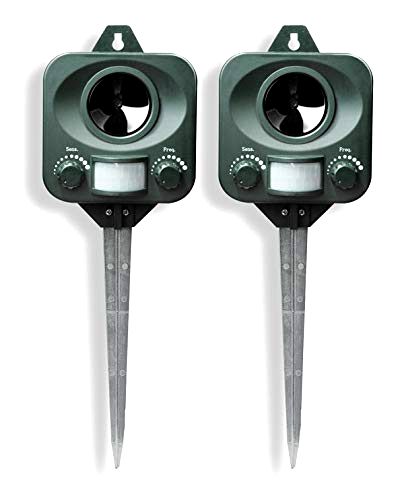
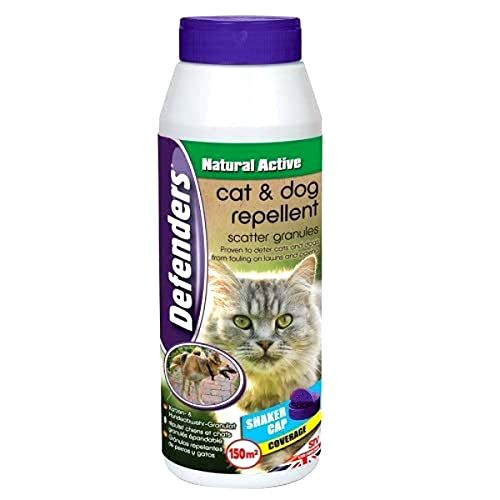
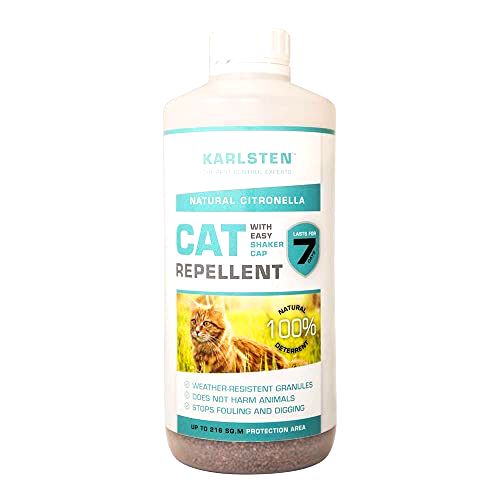

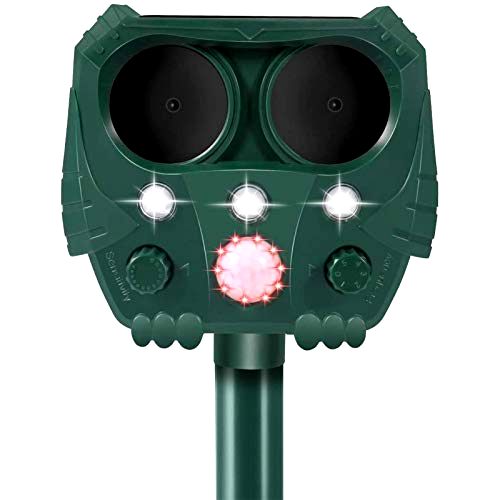

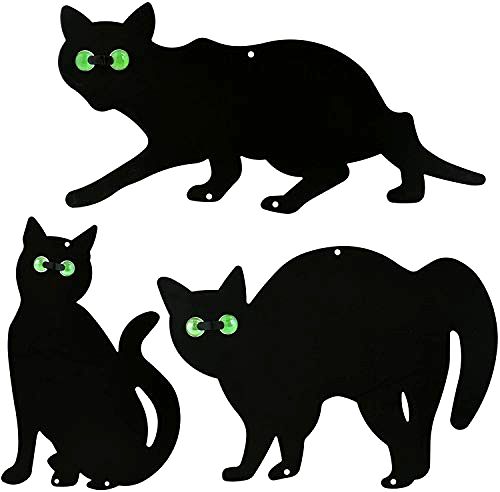

Share